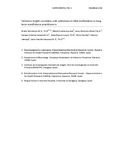Mostrar el registro sencillo del ítem
Telomere length correlates with subtelomeric DNA methylation in long-term mindfulness practitioners
| dc.creator | Mendióroz Iriarte, Maite | es_ES |
| dc.creator | Puebla Guedea, Marta | es_ES |
| dc.creator | Montero Marín, Jesús | es_ES |
| dc.creator | Urdánoz Casado, Amaya | es_ES |
| dc.creator | Labarga, Alberto | es_ES |
| dc.date.accessioned | 2020-08-06T08:35:32Z | |
| dc.date.available | 2020-08-06T08:35:32Z | |
| dc.date.issued | 2020 | |
| dc.identifier.issn | 2045-2322 | |
| dc.identifier.uri | https://hdl.handle.net/2454/37750 | |
| dc.description.abstract | Mindfulness and meditation techniques have proven successful for the reduction of stress and improvement in general health. In addition, meditation is linked to longevity and longer telomere length, a proposed biomarker of human aging. Interestingly, DNA methylation changes have been described at specific subtelomeric regions in long-term meditators compared to controls. However, the molecular basis underlying these beneficial effects of meditation on human health still remains unclear. Here we show that DNA methylation levels, measured by the Infinium HumanMethylation450 BeadChip (Illumina) array, at specific subtelomeric regions containing GPR31 and SERPINB9 genes were associated with telomere length in long-term meditators with a strong statistical trend when correcting for multiple testing. Notably, age showed no association with telomere length in the group of long-term meditators. These results may suggest that long-term meditation could be related to epigenetic mechanisms, in particular gene-specific DNA methylation changes at distinct subtelomeric regions. | en |
| dc.description.sponsorship | The project has received funding from the Network for Prevention and Health Promotion in primary Care (RD12/0005 and RD16/0007/0005) grant and a FIS grant (PI16/00962) from the Instituto de Salud Carlos III of the Spanish Ministry of Economy and Competitiveness, co-financed with European Union ERDF funds. MM has received a grant 'intensificación' from Fundación LaCaixa. | en |
| dc.format.extent | 12 p. | |
| dc.format.mimetype | application/pdf | en |
| dc.language.iso | eng | en |
| dc.publisher | Nature Research | en |
| dc.relation.ispartof | Scientific Reports, 2020, 10 (1):4564 | en |
| dc.rights | © The Author(s) 2020. This article is licensed under a Creative Commons Attribution 4.0 International License, which permits use, sharing, adaptation, distribution and reproduction in any medium or format, as long as you give appropriate credit to the original author(s) and the source, provide a link to the Creative Commons license, and indicate if changes were made. Te images or other third party material in this article are included in the article’s Creative Commons license, unless indicated otherwise in a credit line to the material. If material is not included in the article’s Creative Commons license and your intended use is not permitted by statutory regulation or exceeds the permitted use, you will need to obtain permission directly from the copyright holder. | en |
| dc.rights.uri | http://creativecommons.org/licenses/by/4.0/ | |
| dc.subject | Biomarkers | en |
| dc.subject | DNA methylation | en |
| dc.subject | Mindfulness | en |
| dc.subject | Meditation | en |
| dc.title | Telomere length correlates with subtelomeric DNA methylation in long-term mindfulness practitioners | en |
| dc.type | info:eu-repo/semantics/article | en |
| dc.type | Artículo / Artikulua | es |
| dc.contributor.department | Ciencias de la Salud | es_ES |
| dc.contributor.department | Osasun Zientziak | eu |
| dc.rights.accessRights | info:eu-repo/semantics/openAccess | en |
| dc.rights.accessRights | Acceso abierto / Sarbide irekia | es |
| dc.identifier.doi | 10.1038/s41598-020-61241-6 | |
| dc.relation.projectID | info:eu-repo/grantAgreement/MINECO//AGL2015-70584-C2-2-R/ES/ | en |
| dc.relation.publisherversion | https://doi.org/10.1038/s41598-020-61241-6 | |
| dc.type.version | info:eu-repo/semantics/publishedVersion | en |
| dc.type.version | Versión publicada / Argitaratu den bertsioa | es |
Ficheros en el ítem
Este ítem aparece en la(s) siguiente(s) colección(ones)
La licencia del ítem se describe como © The Author(s) 2020. This article is licensed under a Creative Commons Attribution 4.0 International
License, which permits use, sharing, adaptation, distribution and reproduction in any medium or
format, as long as you give appropriate credit to the original author(s) and the source, provide a link to the Creative Commons license, and indicate if changes were made. Te images or other third party material in this
article are included in the article’s Creative Commons license, unless indicated otherwise in a credit line to the
material. If material is not included in the article’s Creative Commons license and your intended use is not permitted by statutory regulation or exceeds the permitted use, you will need to obtain permission directly from the copyright holder.




